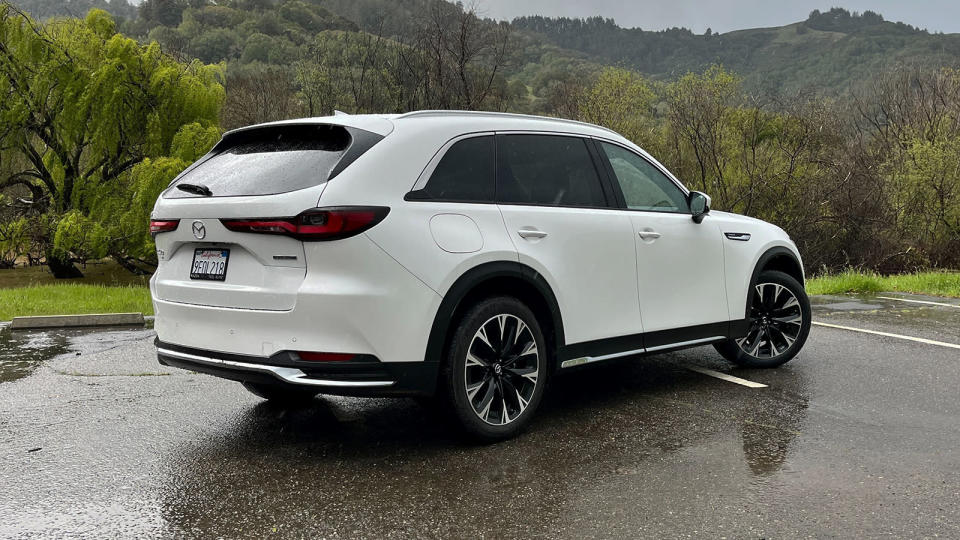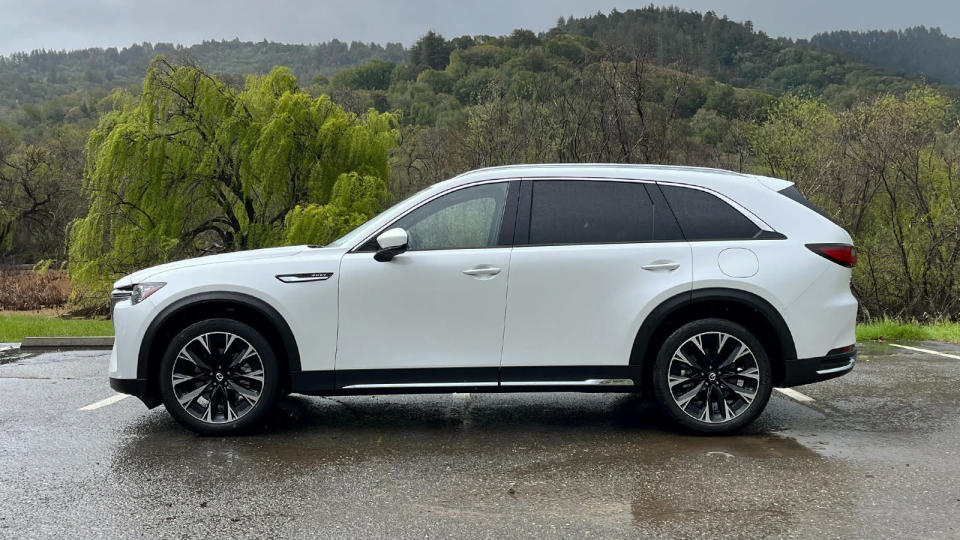2024 Mazda CX-90 First Drive Review: A family SUV for the discerning driver

Mazda's biggest vehicle is finally here, the 2024 CX-90. And it's big for more reasons than just its physical size. It's the first opportunity for us to experience the brand's new rear-drive-biased architecture. And its all-new turbocharged inline-six engine. And its first plug-in hybrid. It's packed with all kinds of things that make us excited, and they're all components that will become key to future Mazda products. That means all those new bits need to work well together. Further, considering how competitive this segment is, there’s even more pressure on Mazda for the CX-90 to be good. Fortunately for Mazda, the CX-90 is superb to drive with available interiors that put it on par with some real upscale brands. It's not perfect, but it's very good, and it's a good sign for future Mazdas.
The most important and exciting aspects of the CX-90 are the bits underneath the skin. Unlike the CX-9 it replaces, the CX-90 runs its engines length-wise (or longitudinally) rather than sideways (transversely), and the all-wheel-drive system mainly sends power to the rear, rather than the front.
Those engines are very different, too. First off, there's more than just the one engine option, and all of them are more powerful than the CX-9's turbo-four. The base engine for the CX-90 Turbo is a turbocharged 3.3-liter double-overhead-cam inline-six that makes 280 horsepower and 332 pound-feet of torque. There's a CX-90 Turbo S that has a high-output version of the engine making 340 hp and 369 lb-ft of torque. That's on 93 octane. It will also run on regular fuel but with a dip to 319 hp. Both engines feature a 48-volt electric motor placed between the engine and transmission that provides hybrid assist. It's more efficient than the old, less-powerful turbo four, too. The base model gets 24 mpg in the city, 28 on the highway and 25 combined. The high-output model is basically the same except for getting 23 mpg in the city. Both engines are also available with a towing package that allows the CX-90 to pull as much as 5,000 pounds. Without it, it can pull 3,500 pounds.
Sort of in-between the six-cylinder engines is the plug-in hybrid. This uses a version of Mazda's tried-and-true naturally aspirated 2.5-liter four-cylinder that you'll find in basically everything it sells in America. It's paired with an electric motor that fits in the same place between the engine and transmission as other hybrids, but it's much larger and more powerful. The electric motor on its own makes 173 hp and 199 lb-ft of torque. When combined with the gas engine's 189 hp and 192 lb-ft of torque, you get a maximum output of 323 hp and 369 lb-ft. That's nearly identical to the top-level six-cylinder. And being a plug-in hybrid, it can use its 17.8 kilowatt-hour battery to drive an estimated 26 miles on electricity. Overall fuel economy numbers haven't been announced yet, though. No towing package is available with the PHEV, so capacity is limited to 3,500 pounds.
We only had the opportunity to try out the top-spec six-cylinder and the plug-in hybrid, and both impressed. The six is just as smooth as you'd hope, and it has a deep, gargling growl. But it does so with an indoor voice, so as not to disturb occupants. Mid-range power and torque are copious and with the quick-spooling turbo, you don't have to wait long to get it. It's a bit of a shame that it runs out of revs so quickly – redline is 6,500 rpm – because it's a fun engine. But since power starts tapering off at the high end, it's not like there was much more to get from spinning it higher. The 48-volt hybrid assist is more than just a slightly smoother start-stop system, too. Similar to various German luxury cars, it can completely shut off the engine when coasting, instead of waiting to come to a complete stop. Unlike Mercedes’ system, for instance, little pulses can be felt when the CX-90’s engine reengages, so a little more fine tuning could be in order there. The restarts from a complete stop could also be smoothed out. But on the whole, the six is sweet.
As good as the six is, the PHEV shouldn't be overlooked, and in some cases is actually an improvement over the six. Obviously it will be more efficient, but the transitions between switching the engine on and off are much smoother. And with more electric grunt and no turbocharger, throttle response feels sharper. You get a bunch more torque down low, which is nice for punting around town. The four-cylinder is also happy to rev like the six cylinder. It's a bit buzzier, but not by a large margin, and volume is still low. And with both engine and motor working together, it feels every bit as quick as the six cylinder. The PHEV does feel a bit slow in EV mode — after all, it's working with about half the horsepower. But it'll still keep up with traffic and get up on-ramps at an acceptable if not exhilarating rate.
It would also be nice if there was just a bit more range. The Volvo XC90 Recharge has extended its electric range to 35 miles, and the Kia Sorento PHEV gets 32 miles. The Jeep Grand Cherokee 4xe matches the Mazda at 26 miles, though it's just a two-row.

All powertrains get the same transmission and driveline. The transmission is an eight-speed automatic that was completely engineered in-house by Mazda, a requirement to get it as small and light as possible for packaging. Instead of using a torque converter, the new transmission has a wet clutch that allows for the relatively compact dimensions of an automatic with its planetary gearsets, along with the direct connection and efficiencies of a clutched transmission (such as a dual-clutch automatic).
This transmission is a solid one. Shifts are very smooth across the board, including in Sport mode. It picks gears well, opting for low rpm and efficiency for the most part in Normal mode, and holding revs and downshifting earlier in sport mode. It also rarely has to make multiple up- or downshifts consecutively to find the right gear, but it's not particularly quick. Particularly when matting the throttle down to the kick-down detent, it takes a moment for everything to respond to the request. There's a manual mode that can be set to stay on when engaged, and once you adjust to the slight delay in shifts, it's fun to pick gears yourself.
The new powertrain also made it possible for Mazda to implement some chassis upgrades. With more space on either side of the engine, Mazda was able to use a double-wishbone design, generally considered one of the best possible front suspension setups, instead of MacPherson struts. The rear retains a multilink design. The added room up front also allows for additional steering lock, so the CX-90's turning circle is actually tighter than the CX-9, despite having a longer wheelbase.


 Yahoo Autos
Yahoo Autos 
